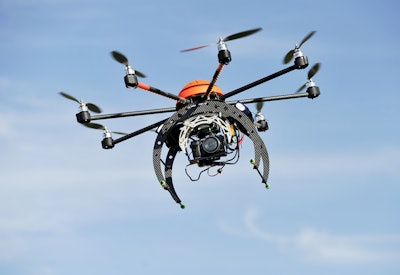
Two Australian companies are providing what they feel is a faster and safer way to inspect or audit dangerous and inaccessible areas. Soto Consulting Engineers aerial photography specialist Coptercam use remote control flying equipment, commonly known as drones. The solution largely eliminates reliance on teams of personnel, rigging and scaffolding and the dangers involved, plus it cuts down much of the time it previously took for inspections of large scale plant and equipment.
The drone alternative puts more control into the hands of proprietors through major cost savings and the near-elimination of shutdowns for plant audits. “Heavy industrial and mining environments, for instance, are harsh on both the service personnel and equipment, plus the downtime associated with work can be a very expensive exercise,” said Managing Director of Soto Group, Mr Frank Soto. “Safety of the people involved is always at some sort of risk as inspection procedures normally involve an element of physical danger. Then there are cases where the overall condition of structures on some sites is perpetually overlooked because access is difficult, dangerous and expensive for operators and auditors.”
Soto Consulting Engineers’ association with Coptercam opens many new possibilities across a range of industries including civil engineering, mining, bulk handling, forensic engineering, and for services to the manufacturing and minerals processing sectors. The drone solution through Soto/Coptercam involves very few people and can achieve in a single day what traditional means would in a week.
For example, where a team of professionals would be assembled with harnesses, scaffolding and other structures, a Coptercam craft is simply flown into the affected areas with a specially mounted camera capable of high resolution photo stills and video or thermal imaging.
The drone is operated remotely at a safe base on the ground by a fully certified Coptercam pilot alongside a Soto engineer viewing a HD monitor in real time during the inspection exercise. Coptercam operation is a two-person crew (pilot and camera operator) which divides the task of controlling the aircraft and focusing on the image capture. This is safer and ensures a better result. Also, the camera is mounted on a 3-axis gyro-stabilised gimbal that is controlled independently of the aircraft above - in both 360 degree pan (rotation) and 110 degrees of tilt - with remote record control and shutter control.
Structures already been inspected by Coptercam technology include bridges, exhaust stacks, roads, elevated conveyors and handling towers. Generally, a site normally doesn’t even need a shutdown and the manual tasks and expensive associated infrastructure which used to take a week now only take a single day. “Statutory audits in the coal mining sector will be one of the real beneficiaries of our new solution,” said Mr Soto. “The coal mining industry provides for statutory structural audits to be undertaken annually to locate potential hazards arising through vibration, stress fatigue or corrosion. These audits presently consume significant man hours. Often difficult access and terrain precludes many structures from complete inspection and the true condition of the structure or plant remains unseen and unreported possibly for years, thus giving rise to hazardous issues and expensive consequences.”
Coptercam’s Mr Glen McGarry says traditional methods of site inspection – whether at a mine site, exhaust stack, bulk handling facility or high rise structure – always involve a rather large team of people, a lot of OH&S induction and familiarisation, and a lot of time to complete. “Whereas traditionally there has always been a risk of people and contractors getting injured, the use of drones minimises risk especially at heights or confined spaces. For example, the legal height limit for us to fly a drone is 122 m (400 feet), so to inspect a smoke stack we simply fly the drone straight up from the ground 122 m high (legal height limit), whereas before it used to involve personnel on ropes coming in from the top which is slow and is putting lives at risk. Our task with Soto is to photograph or video the infrastructure in a systematic manner to document the structure and make an assessment,” said Mr McGarry.
The company has offices in Perth, Sydney, Melbourne, South Australia and a satellite office in Brisbane. “In the hands of an accredited expert, a drone can be mounted with a camera of choice (24MP with real-time zoom function or 36MP fixed), positioned to hover in the air at any chosen viewing point, take as many photographs as required which are then analysed by Soto engineers back at the office. Therefore, the team can easily work out what sort of remediation is required without sending a single human being into the danger zone. Importantly, in real-time via the HD live camera feed to the ground, the attending SOTO engineer can direct Coptercam to focus on a specific area of interest as a hazard is identified."



















